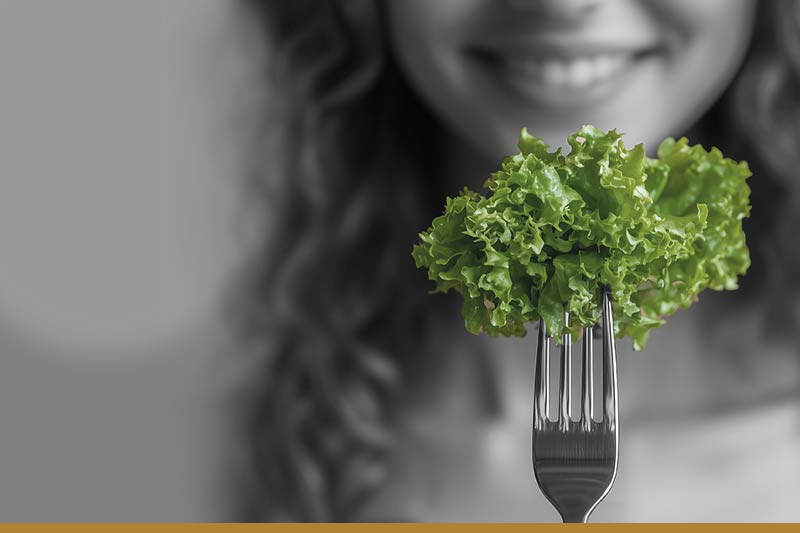As weight gain, obesity, and eating disorders become global medical concerns, the health and beauty industries are coming up with an array of health and weight loss advice. They range from science-based nutritional plans to quick, fad diets.
In the overwhelming mix of diet recommendations, one “program” distinctly stands out – intuitive eating.
This article explains intuitive eating, how to get started with its ten basic principles, and what benefits to expect from this anti-diet approach.

Intuitive eating is an approach to eating that helps us relearn how our ancestors ate by listening to internal hunger and fullness cues rather than external rules or restrictions. It advocates eating when hungry, stopping when full, and having a positive relationship with both food and your body.
Although it sounds like common sense, many people have lost this internal compass due to chronic stress, emotional triggers, and hormonal imbalances. These factors lead to overeating and various psychological struggles related to food and body image.
Intuitive eating is referred to as an anti-diet approach because it instructs people to unlearn what the dieting culture has promoted for decades:
Nutritionists advocating intuitive eating don’t recommend any specific foods, calorie amount, or periods of eating. Instead, they teach patients to recognize the symptoms of physical hunger, pay attention to how they feel during a meal, take pleasure in food, and foster body positivity, letting go of the idea that they should look a specific way.
Intuitive and mindful eating have overlapping elements. People often mistakenly think of them as synonymous.
Mindfulness is a philosophy that promotes a heightened awareness of one’s senses and emotions in relationship to the outside world and the present moment. Applied to eating, mindfulness involves focusing on the meal’s taste, texture, smell, and the sensations it evokes, reflecting on how it was sourced and prepared, and appreciating how it nourishes the body.
While intuitive eating can include these aspects, it prioritizes developing a healthy relationship with one’s body and following the natural hunger signals. It focuses more on internal attunement than on the eating experience.
The concept of intuitive eating first appeared in 1995 in the eponymous book written by registered dietitian nutritionists Evelyn Tribole and Elyse Resch. The authors wanted to help patients relearn the natural principles of following hunger and satiety cues and reject dieting principles, which often lead to low self-esteem, health concerns due to weight fluctuations, and psychological and mental problems.
Evelyn Tribole and Elyse Resch based their findings on previous research on emotional eating and weight loss practices, mostly from the 1970s and ‘80s.
Evelyn Tribole and Elyse Resch came up with ten principles of intuitive eating that explain the framework in a straightforward manner.
The diet culture perpetuates the false idea that having a thin body solves various problems in life. It traps people in an obsessive state of constantly thinking about food, trying to lose weight, and feeling guilty for failing. People can adopt intuitive eating habits and a healthier mindset by rejecting the diet culture and restrictive eating.
This principle reminds people to listen to their hunger cues and eat when hungry. Restricting calories and allowing oneself to become excessively hungry often lead to overeating. Giving the body the nutrients it needs when it needs them builds trust with the body.
Restricting certain foods can build intense cravings for them, which results in binge eating. With intuitive eating, all foods are allowed. People are better at moderation when they know they can have more of their favorite food the following day.
People on diets usually associate enjoying food with an inability to eat in moderation. Taking pleasure in food is seen as a threat to weight loss. In contrast, the advocates of intuitive eating emphasize the importance of satisfaction in the eating experience, believing it helps people better recognize satiety signals.
Like mindful eating, intuitive eating is about listening to satiety cues and trusting oneself to put away food when comfortably full. It requires eating slowly and pausing between bites to reflect on how the food tastes and the feeling of fullness.
The food police in one’s mind repeats phrases learned from the diet culture. It sets rules about what and how to eat. It is necessary to silence the food police to allow room for intuitive eating.
Intuitive eating allows people to tap into their emotions gently, without guilt and pressure. It helps them recognize that food can’t solve life’s problems and dispel unpleasant feelings. It may help them feel good for a brief moment, but overeating often leads to digestive and other symptoms, adding more discomfort and pain to existing problems.
A big part of intuitive eating is learning to respect and love one’s body, regardless of size and shape. It helps people abandon unrealistic expectations and feel good about themselves.
Intuitive eating also teaches people intuitive movement. It promotes physical activity that feels good and doesn’t follow an overly structured plan for melting fat and calories. Enjoying a workout is the prerequisite for consistency in exercising and experiencing the health benefits of regular activity.
Intuitive eating doesn’t promote weight loss, but it emphasizes the importance of making optimal food choices. Without strictly observing what they eat, people should listen to what their bodies need and crave, and eat in a way that makes them feel light, comfortable, energized, and satisfied.

Since the book came out, numerous studies have analyzed the structure and effectiveness of intuitive eating. Many suggest the following physiological, emotional, and mental benefits of the anti-diet framework:
Some researchers recognize a few challenges of intuitive eating. They argue that an approach without specific rules regarding what and when to eat leaves too much room for loss of control and overeating. This especially concerns patients with a food addiction stemming from a neurobiological source, such as in a drug addiction. An addiction to highly palatable, calorie-dense foods may need a more structured plan than intuition because intuitive signals can be overwhelmed by intense cravings.
Another challenge is that the freedom to choose any food may not be suitable for patients with more severe, chronic diseases, such as diabetes.
That said, current evidence suggests improved health markers in people who practice intuitive eating. Patients with chronic diseases should discuss the adequate dietary approach for their condition with their healthcare provider or a registered dietitian.
Here are some practical tips on getting started with intuitive eating:
The following lists can help you identify physical and emotional hunger cues.
Physical hunger:
Emotional hunger:
Intuitive eating is a unique approach to nutrition that focuses on attuning the mind and body, and responding to natural hunger cues instead of emotional cravings. It rejects the diet culture and helps patients embrace their bodies regardless of size. This more accepting, less restraining method often improves physical and mental health.




4325 E Indian School Rd, Suite 130
Phoenix, AZ 85018
United States
(480) 422-2058
info@vibrantvitalityclinic.com
Monday - Friday: 9:00 am - 6:00 pm
Saturday: 9:00 am - 3:00 pm
Sunday: Closed
